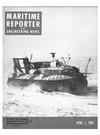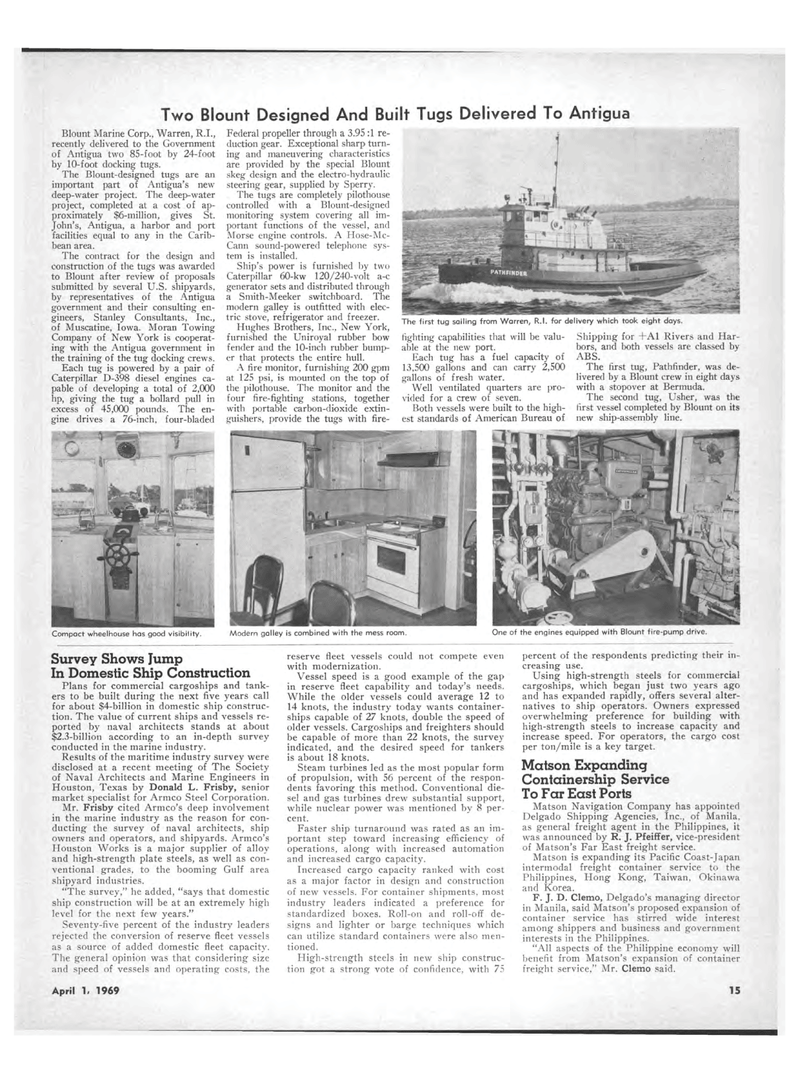
Page 13: of Maritime Reporter Magazine (April 1969)
Read this page in Pdf, Flash or Html5 edition of April 1969 Maritime Reporter Magazine
Two Blount Designed And Built Tugs Delivered To Antigua Blount Marine Corp., Warren, R.I., recently delivered to the Government of Antigua two 85-foot by 24-foot by 10-foot docking tugs. The Blount-designed tugs are an important part of Antigua's new deep-water project. The deep-water project, completed at a cost of ap-proximately $6-million, gives St. John's, Antigua, a harbor and port facilities equal to any in the Carib-bean area. The contract for the design and construction of the tugs was awarded to Blount after review of proposals submitted by several U.S. shipyards, by representatives of the Antigua government and their consulting en-gineers, Stanley Consultants, Inc., of Muscatine, Iowa. Moran Towing Company of New York is cooperat-ing with the Antigua government in the training of the tug docking crews. Each tug is powered by a pair of Caterpillar D-398 diesel engines ca-pable of developing a total of 2,000 hp, giving the tug a bollard pull in excess of 45,000 pounds. The en-gine drives a 76-inch, four-bladed Federal propeller through a 3.95:1 re-duction gear. Exceptional sharp turn-ing and maneuvering characteristics are provided by the special Blount skeg design and the electro-hydraulic steering gear, supplied by Sperry. The tugs are completely pilothouse controlled with a Blount-designed monitoring system covering all im-portant functions of the vessel, and Morse engine controls. A Hose-Mc-Cann sound-powered telephone sys-tem is installed. Ship's power is furnished by two Caterpillar 60-kw 120/240-volt a-c generator sets and distributed through a Smith-Meeker switchboard. The modern galley is outfitted with elec-tric stove, refrigerator and freezer. Hughes Brothers, Inc., New York, furnished the Uniroyal rubber bow fender and the 10-inch rubber bump-er that protects the entire hull. A fire monitor, furnishing 200 gpm at 125 psi, is mounted on the top of the pilothouse. The monitor and the four fire-fighting stations, together with portable carbon-dioxide extin-guishers, provide the tugs with fire-fighting capabilities that will be valu-able at the new port. Each tug has a fuel capacity of 13,500 gallons and can carry 2,500 gallons of fresh water. Well ventilated quarters are pro-vided for a crew of seven. Both vessels were built to the high-est standards of American Bureau of Shipping for +A1 Rivers and Har-bors, and both vessels are classed by ABS. The first tug, Pathfinder, was de-livered by a Blount crew in eight days with a stopover at Bermuda. The second tug, Usher, was the first vessel completed by Blount on its new ship-assembly line. Modem galley is combined with the mess room. Survey Shows Jump In Domestic Ship Construction Plans for commercial cargoships and tank-ers to be built during the next five years call for about $4-billion in domestic ship construc-tion. The value of current ships and vessels re-ported by naval architects stands at about $2.3-billion according to an in-depth survey conducted in the marine industry. Results of the maritime industry survey were disclosed at a recent meeting of The Society of Naval Architects and Marine Engineers in Houston, Texas by Donald L. Frisby, senior market specialist for Armco Steel Corporation. Mr. Frisby cited Armco's deep involvement in the marine industry as the reason for con-ducting the survey of naval architects, ship owners and operators, and shipyards. Armco's Houston Works is a major supplier of alloy and high-strength plate steels, as well as con-ventional grades, to the booming Gulf area shipyard industries. "The survey," he added, "says that domestic ship construction will be at an extremely high level for the next few years." Seventy-five percent of the industry leaders rejected the conversion of reserve fleet vessels as a source of added domestic fleet capacity. The general opinion was that considering size and speed of vessels and operating costs, the reserve fleet vessels could not compete even with modernization. Vessel speed is a good example of the gap in reserve fleet capability and today's needs. While the older vessels could average 12 to 14 knots, the industry today wants container-ships capable of 27 knots, double the speed of older vessels. Cargoships and freighters should be capable of more than 22 knots, the survey indicated, and the desired speed for tankers is about 18 knots. Steam turbines led as the most popular form of propulsion, with 56 percent of the respon-dents favoring this method. Conventional die-sel and gas turbines drew substantial support, while nuclear power was mentioned by 8 per-cent. Faster ship turnaround was rated as an im-portant step toward increasing efficiency of operations, along with increased automation and increased cargo capacity. Increased cargo capacity ranked with cost as a major factor in design and construction of new vessels. For container shipments, most industry leaders indicated a preference for standardized boxes. Roll-on and roll-off de-signs and lighter or barge techniques which can utilize standard containers were also men-tioned. High-strength steels in new ship construc-tion got a strong vote of confidence, with 75 percent of the respondents predicting their in-creasing use. Using high-strength steels for commercial cargoships, which began just two years ago and has expanded rapidly, offers several alter-natives to ship operators. Owners expressed overwhelming preference for building with high-strength steels to increase capacity and increase speed. For operators, the cargo cost per ton/mile is a key target. Matson Expanding Containership Service To Far East Ports Matson Navigation Company has appointed Delgado Shipping Agencies, Inc., of Manila, as general freight agent in the Philippines, it was announced by R. J. Pfeiffer, vice-president of Matson's Far East freight service. Matson is expanding its Pacific Coast-Japan intermodal freight container service to the Philippines, Hong Kong, Taiwan, Okinawa and Korea. F. J. D. Clemo, Delgado's managing director in Manila, said Matson's proposed expansion of container service has stirred wide interest among shippers and business and government interests in the Philippines. "All aspects of the Philippine economy will benefit from Matson's expansion of container freight service," Mr. Clemo said. The first tug sailing from Warren, R.I. for delivery which took eight days Compact wheelhouse has good visibility. One of the engines equipped with Blount fire-pump drive. April 1 / 1969 15

 12
12

 14
14
